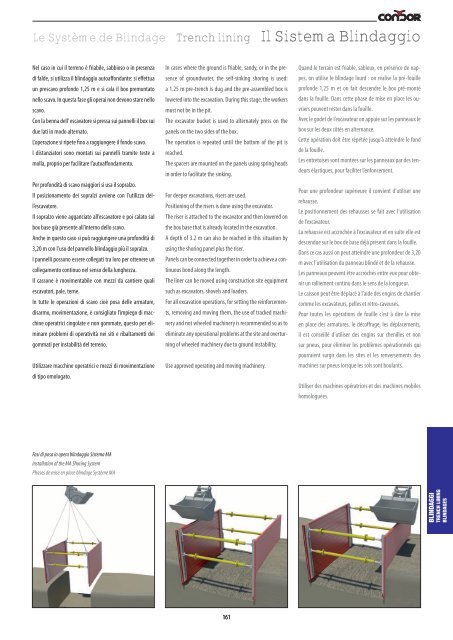BLINDAGGI - Condor
BLINDAGGI - Condor
BLINDAGGI - Condor
Create successful ePaper yourself
Turn your PDF publications into a flip-book with our unique Google optimized e-Paper software.
Le Système de Blindage Trench lining Il Sistema Blindaggio<br />
Nel caso in cui il terreno è friabile, sabbioso o in presenza<br />
di falde, si utilizza il blindaggio autoaffondante: si effettua<br />
un prescavo profondo 1,25 m e si cala il box premontato<br />
nello scavo. In questa fase gli operai non devono stare nello<br />
scavo.<br />
Con la benna dell’ escavatore si pressa sui pannelli il box sui<br />
due lati in modo alternato.<br />
L’operazione si ripete fino a raggiungere il fondo scavo.<br />
I distanziatori sono montati sui pannelli tramite teste a<br />
molla, proprio per facilitare l’autoaffondamento.<br />
Per profondità di scavo maggiori si usa il sopralzo.<br />
Il posizionamento dei sopralzi avviene con l’utilizzo dell’escavatore.<br />
Il sopralzo viene agganciato all’escavatore e poi calato sul<br />
box base già presente all’interno dello scavo.<br />
Anche in questo caso si può raggiungere una profondità di<br />
3,20 m con l’uso del pannello blindaggio più il sopralzo.<br />
I pannelli possono essere collegati tra loro per ottenere un<br />
collegamento continuo nel senso della lunghezza.<br />
Il cassone è movimentabile con mezzi da cantiere quali<br />
escavatori, pale, terne.<br />
In tutte le operazioni di scavo cioè posa delle armature,<br />
disarmo, movimentazione, è consigliato l’impiego di macchine<br />
operatrici cingolate e non gommate, questo per eliminare<br />
problemi di operatività nei siti e ribaltamenti dei<br />
gommati per instabilità del terreno.<br />
Utilizzare macchine operatrici e mezzi di movimentazione<br />
di tipo omologato.<br />
Fasi di posa in opera blindaggio Sistema MA<br />
Installation of the MA Shoring System<br />
Phases de mise en place blindage Système MA<br />
In cases where the ground is friable, sandy, or in the presence<br />
of groundwater, the self-sinking shoring is used:<br />
a 1.25 m pre-trench is dug and the pre-assembled box is<br />
lowered into the excavation. During this stage, the workers<br />
must not be in the pit.<br />
The excavator bucket is used to alternately press on the<br />
panels on the two sides of the box.<br />
The operation is repeated until the bottom of the pit is<br />
reached.<br />
The spacers are mounted on the panels using spring heads<br />
in order to facilitate the sinking.<br />
For deeper excavations, risers are used.<br />
Positioning of the risers is done using the excavator.<br />
The riser is attached to the excavator and then lowered on<br />
the box base that is already located in the excavation.<br />
A depth of 3.2 m can also be reached in this situation by<br />
using the shoring panel plus the riser.<br />
Panels can be connected together in order to achieve a continuous<br />
bond along the length.<br />
The liner can be moved using construction site equipment<br />
such as excavators, shovels and loaders.<br />
For all excavation operations, for setting the reinforcements,<br />
removing and moving them, the use of tracked machinery<br />
and not wheeled machinery is recommended so as to<br />
eliminate any operational problems at the site and overturning<br />
of wheeled machinery due to ground instability.<br />
Use approved operating and moving machinery.<br />
161<br />
Quand le terrain est friable, sableux, en présence de nappes,<br />
on utilise le blindage lourd : on réalise la pré-fouille<br />
profonde 1,25 m et on fait descendre le box pré-monté<br />
dans la fouille. Dans cette phase de mise en place les ouvriers<br />
peuvent rester dans la fouille.<br />
Avec le godet de l’excavateur on appuie sur les panneaux le<br />
box sur les deux côtés en alternance.<br />
Cette opération doit être répétée jusqu’à atteindre le fond<br />
de la fouille.<br />
Les entretoises sont montées sur les panneaux par des tendeurs<br />
élastiques, pour faciliter l’enfoncement.<br />
Pour une profondeur supérieure il convient d’utiliser une<br />
rehausse.<br />
Le positionnement des rehausses se fait avec l’utilisation<br />
de l’excavateur.<br />
La rehausse est accrochée à l’excavateur et en suite elle est<br />
descendue sur le box de base déjà présent dans la fouille.<br />
Dans ce cas aussi on peut atteindre une profondeur de 3,20<br />
m avec l’utilisation du panneau blindé et de la rehausse.<br />
Les panneaux peuvent être accrochés entre eux pour obtenir<br />
un ralliement continu dans le sens de la longueur.<br />
Le caisson peut être déplacé à l’aide des engins de chantier<br />
comme les excavateurs, pelles et rétro-caveuses.<br />
Pour toutes les opérations de fouille c’est à dire la mise<br />
en place des armatures, le décoffrage, les déplacements,<br />
il est conseillé d’utiliser des engins sur chenilles et non<br />
sur pneus, pour éliminer les problèmes opérationnels qui<br />
pourraient surgir dans les sites et les renversements des<br />
machines sur pneus lorsque les sols sont boulants.<br />
Utiliser des machines opératrices et des machines mobiles<br />
homologuées.<br />
<strong>BLINDAGGI</strong><br />
TRENCH LINING<br />
BLINDAGES


